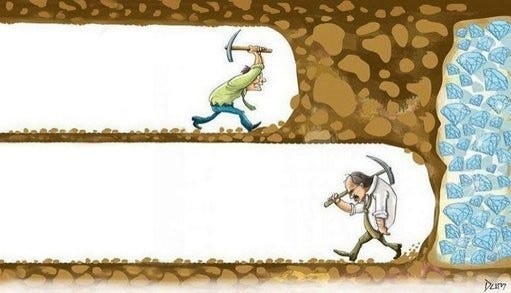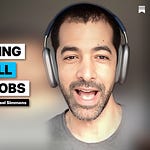Jeff Bezos just did his first long-form interview EVER. And it did not disappoint.
In a Lex Fridman Show interview, we learn:
Bezos is busier than ever.
He spends 1+ hours per day exercising.
His main focus is now Blue Origin, his space company.
His top mental models for invention and problem solving.
Why It Resonated
I particularly appreciated the clip, because it resonated with what I’ve been learning over the last 8 years as I study the creativity, problem-solving, and learning strategies of the world’s top innovators (Elon Musk, Ray Dalio, Leonard Da Vinci, Jeff Bezos, Thomas Edison, Einstein, Frederick Taylor).
Today’s Game Plan
Here are my three main takeaways for thought leaders from the clip:
Rule Of 100: It takes 100 stones to find a gem.
Ten ideas from brainstorming. A thousand from search.
Efficiency at its peak leaves creativity weak.
In this post, I breakdown each of these takeaways and connect them to case studies of other top performers I’ve studied over the years.
#1: Rule Of 100: 100 stones for every one gem
Bezos Quote
If you want to boil down what I am, I'm really an inventor. And I look at things and I can come up with atypical solutions. Then I can create 100 such atypical solutions for something. 99 of them may not survive scrutiny, but one of those 100 is like, maybe that might work, and then you can keep going from there.
Related Case Study: Thomas Edison
Bezos’ approach is right out of Thomas Edison’s system for creativity. The following anecdote from Innovate Like Edison shows the similarity:
A member of his staff who’d worked with Edison for twenty years remarked: “Edison can think of more ways of doing a thing than any man I ever saw or heard of.”
In one classic case, Edison asked one of his engineers to submit some sketches representing possible approaches to the creation of a new piece of specialized ore-milling machinery. The engineer generated three drawings that he promptly submitted to his boss. Edison wasn’t satisfied, but the engineer protested that there was no other way to proceed. As Dyer and Martin recount the conversation, “Mr. Edison turned to him quickly and said: ‘Do you mean to say that these drawings represent the only way to do this work?’ To which he received the reply: ‘I certainly do.’”This exchange took place on a Saturday afternoon. After a day off, Edison stopped by the engineer’s desk first thing on Monday morning and casually handed him a folder that contained forty-eight different designs for the new equipment. And, Edison’s prolific idea generation wasn’t just an academic exercise; one of his sketches formed the basis for the successful development of the new equipment.
Although it was rare for Edison to boast about his own genius, he admitted to being prolific with ideas. “I speak without exaggeration,” he noted to a reporter, “when I say that I have constructed three thousand different theories in connection with the electric light, each one of them reasonable and apparently likely to be true.”
Thought Leader Takeaway
When brainstorming options for decisions, it’s easy to fall for availability bias. This is our tendency to:
Just brainstorm a few possibilities
Go with the first idea that sounds good enough
For example, when coming up with article ideas, it’s very easy to brainstorm a few ideas and simply write something because you can, and because it feels like a good idea.
Or think about the last car you leased or purchased. If you’re like most people, you probably immediately constrained your search space to a few brands and models based on what you or others close to you have driven before rather than considering all of your options.
The availability bias is great when making small decisions. It helps you rapidly get to a “good enough” decision. However, it’s very dangerous with big-stakes decisions where one possibility could be 100x or even 1,000x better.
Choosing article ideas happens to be one of those big-stakes decisions that benefit from brainstorming 100+ possibilities. One article could make someone’s career.
After watching this Bezos’ clip, I realize I have become a little lazy about picking article topics. As a result, I’m going to set aside one session per month to brainstorm 100 new ideas to write about for the upcoming month.
\
#2: Ten ideas from brainstorming. A thousand from search.
Bezos Quote
That kind of inventiveness in a high-dimensionality space where the search space is very large, that's where my inventive skills come.
Search Space Explainer
What you really need to understand is the structure of the space you are thinking of getting into.
—Luis Perez-Breva (MIT Researcher and author)
The idea of a search space comes from the world of computer science. In that context, the search space is “the feasible region defining the set of all possible solutions.”
While the idea started in computer science, I have increasingly seen it used by creative geniuses throughout history. And, I personally find it extremely helpful.
You can think of search space thinking as first defining the grid of all possibilities the solution could fall into and then systematically narrowing down which possibilities are the most likely to be hits.
A great analogy is the board game, Battleship.
Here’s why:
Grid Of Possibilities. The possibilities are laid out in a grid where the rows are dimensions and the columns are variations on each dimension. When it comes to thought leadership, some of the dimensions to brainstorm are format, medium, topic, length, platform, customer, problem, solution, frequency, quality level, etc. Then, for each of these dimensions, there are a finite number of variations to choose from. For example, for the medium dimension, there is text, video, visual and audio.
Hits With Varying Reward Levels. Similar to ideas, most guesses in Battleship aren’t going to hit anything. And of the guesses that are hits, some hits are way more valuable than others.
Mental Models To Narrow Down The Space. To increase your odds of getting a hit on every guess, you use mental models or rules of thumb to narrow your search space. For example, if you get a hit, then you guess the spaces around it. Or, before you have any hits, you try to guess points that aren’t close to one another. When it comes to thought leadership, one can build a model of top performing content by studying the top books ever written and seeing what they have in common. This then provides you with an intuition on which of your ideas will be successful.
By having a grid of possible ideas laid out in front of you, you overcome some of the limitations of typical brainstorming:
Blank Page Problem. With brainstorming, you start with a blank page that can be hard to fill. With search space thinking, you start with a ton of viable ideas.
Dead-End Problem. With brainstorming, it’s easy to hit a dead-end where it’s hard to come up with more than a few new ideas. With search space thinking, you can rapidly generate thousands of possibilities.
In-The-Box thinking. With brainstorming, it’s easy to fall into a rut where you only think of ideas like ones you’ve thought of in the past. With search space thinking, you can see all possibilities, not just ones you’re familiar with.
Bottom line: Using search space thinking is significantly more effective at generating more quantity and more ‘atypical’ ideas.
To get a deeper understanding of real-world search space thinking, I provide you with an overview of the four key steps of this approach applied to a real-world example of selecting a car to buy:










